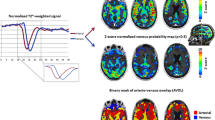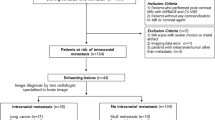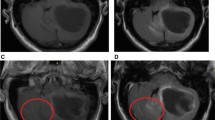Abstract
Background
The evaluation of brain metastases generally requires post-contrast MRI exam, but some patients have contraindication to contrast medium administration.
Purpose
To investigate the value of the MRI diffusion tensor imaging (DTI) for detection of metastatic brain tumor.
Materials and methods
We retrospectively analyzed the MRI data from 23 patients (13 males and 10 females) with brain metastases. The MRI protocol consisted in T1WI, T2WI, post-contrast 3DT1WI and DTI images (b = 1000) sequences. The brain metastatic lesions were counted in each of these sequences. We compared the advantages and limitations of different sequences in the brain metastases detection. The number of metastatic lesions identified on the contrast-enhanced 3DT1WI image is used as the reference. FA values were measured in the intratumoral, adjacent peritumoral and distant peritumoral edema area (PTEA) of brain metastasis, and the differences were statistically analyzed.
Results
DTI can detect more brain metastatic lesions rather than T1WI and T2WI. The number of brain metastases on DTI is similar to post-contrast 3D T1WI. There is no statistical difference in the FA value change between the adjacent and distant PTEA.
Conclusion
The DTI original image can be used as an alternative examination for patients with contraindications to contrast-enhanced MRI. It has high sensitivity to intratumoral hemorrhage, which has advantage to detect brain metastatic lesions as compared with T1WI or T2WI images.






Similar content being viewed by others
References
Owonikoko TK, Robin AM, Shim H et al (2014) Current approaches to the treatment of metastatic brain tumours. Nat Rev Clin Oncol 11:203–222
Menezes ME, Minn I, Sarkar D et al (2016) Detecting tumor metastases: the road to therapy starts here. Adv Cancer Res 132:1–44
Sze G, Heier L, Johnson C et al (1990) Detection of brain metastases: comparison of contrast-enhanced MR with unenhanced MR and enhanced CT. AJNR Am J Neuroradiol 11:785–791
Kaal EC, Taphoorn MJ, Vecht CJ (2005) Symptomatic management and imaging of brain metastases. J Neurooncol 75:15–20
Pope WB (2018) Brain metastases: neuroimaging. Handb Clin Neurol 149:89–112
Davis PC, Hoffman JC Jr, Hudgins PA et al (1991) Diagnosis of cerebral metastases: double-dose delayed CT versus contrast-enhanced MR imaging. AJNR Am J Neuroradiol 12:293–300
Ahn SJ, Chang JH, Chung TS et al (2014) The added value of double dose gadolinium enhanced 3D T2 fluid-attenuated inversion recovery for evaluating small brain metastases. Yonsei Med J 55:1231–1237
Bucci M, Berman JI, Berger MS et al (2013) Quantifying diffusion MRI tractography of the corticospinal tract in brain tumors with deterministic and probabilistic methods. Neuroimage Clin 3:361–368
Tsougos I, Theodorou K, Fezoulidis I et al (2012) Differentiation of glioblastoma multiforme from metastatic brain tumor using proton magnetic resonance spectroscopy, diffusion and perfusion metrics at 3T. Cancer Imaging 12:423–436
Masch WR, Tsien C, Wang PI et al (2016) Comparison of Diffusion tensor imaging and magnetic resonance perfusion imaging in differentiating recurrent brain neoplasm from radiation necrosis. Acad Radiol 23:569–576
Young RJ, Brennan N, Jenabi M et al (2017) Comparison of compressed sensing diffusion spectrum imaging and diffusion tensor Imaging in patients with intracranial masses. Magn Reson Imaging 36:24–31
O’Donnell LJ, Rigolo L, Suter Y et al (2016) Automated white matter fiber tract identification in patients with brain tumors. Neuroimage Clin 13:138–153
Bette S, Boeckh-Behrens T, Gempt J et al (2017) Local fractional anisotropy is reduced in areas with Tumor recurrence in glioblastoma. Radiology 283:499–507
Chaudhary N, Gemmete JJ, Gu Y et al (2015) Diffusion tensor imaging in hemorrhagic stroke. Exp Neurol 272:88–96
Diedenhofen B, Musch J (2015) Cocor: a comprehensive solution for the statistical comparison of correlations. PLoS ONE 10(3):e0121945
Ellingson BM, Erickson BJ, Smits M et al (2015) Consensus recommendations for a standardized brain tumor imaging protocol in clinical trials. Neuro Oncol 17:1188–1198
Jeon JY, Moon WJ, Roh HG et al (2014) Effect of imaging time in the magnetic resonance detection of intracerebral metastases using single dose gadobutrol. Korean J Radiol 15:145–150
Nagai A, Shibamoto Y, Hashizume C et al (2010) Increases in the number of brain metastases detected at frame-fixed, thin-slice MRI for gamma knife surgery planning. Neuro Oncol 12:1187–1192
Gil B, Hwang EJ, Jang J et al (2016) Detection of leptomeningeal metastasis by contrast enhanced 3D T1-SPACE: comparison with 2D FLAIR and contrast-enhanced 2D T1-weighted images. PLoS ONE 11:e0163081
Mayr NA, Muhonen MG, Nguyen HD et al (1994) Cost-effectiveness of high-dose MR contrast studies in the evaluation of brain metastases. AJNR Am J Neuroradiol 15:1053–1061
Toth GB, Varallyay CG, Bashir MR et al (2017) Current and potential imaging applications of ferumoxytol for magnetic resonance imaging. Kidney Int 92:47–66
Subedi KS, Saitoh J, Suzuki Y et al (2013) Usefulness of double dose contrast-enhanced magnetic resonance imaging for clear delineation of gross tumor volume in stereotactic radiotherapy treatment planning of metastatic brain tumors: a dose comparison study. J Radiat Res 54:135–139
Kikuchi K, Obara M, Togao O et al (2015) 3D MR sequence capable of simultaneous image acquisitions with and without blood vessel suppression: utility in diagnosing brain metastases. Eur Radiol 25:901–910
Villanueva-Meyer JE, Cha S, Mabray MC (2017) Current clinical brain tumor imaging. Neurosurgery 81:397–415
Kuhnt D, Kapur T, Richter M et al (2013) Fiber tractography based on diffusion tensor imaging compared with high-angular-resolution diffusion imaging with compressed sensing: initial experience. Neurosurgery 72:165–175
Hoy AR, Kecskemeti SR, Alexander AL (2015) Free water elimination diffusion tractography: a comparison with conventional and FLAIR DTI Acquisitions. J Magn Reson Imaging 42:1572–1581
Richter M, Zolal A, Buchfelder M et al (2013) Evaluation of diffusion-tensor imaging-based global search and tractography for tumor surgery close to the language system. PLoS ONE 8:e50132
Bette S, Wiestler B, Delbridge C, Huber T, Boeckh-Behrens T, Meyer B et al (2016) Discrimination of different brain metastases and primary CNS lymphomas using morphologic criteria and diffusion tensor imaging. Fortschr Röntgenstr 188:1134–1143
Franchino F, Rudà R, Soffietti R (2018) Mechanisms and therapy for cancer metastasis to the brain. Front Oncol 8:161
Caffo M, Caruso G, Cutugno M et al (2013) Innovative therapeutic strategies in the treatment of brain metastases. Int J Mol Sci 14:2135–2174
Hanibuchi M, Kim SJ, Nishioka Y et al (2014) The molecular biology of lung cancer brain metastasis: an overview of current comprehensions and future perspectives. J Med Invest 61:241–253
De Bock K, Carmeliet P, Cauwenberghs S (2011) Vessel abnormalization: another hallmark of cancer? Molecular mechanisms and therapeutic implications. Curr Opin Genet Dev 21:73–79
Wu W, Miller KL (2017) Image formation in diffusion MRI: a review of recent technical developments. J Magn Reson Imaging 46:646–662
Drake-Pérez M, Fitsiori A, Lovblad K et al (2018) Clinical applications of diffusion weighted imaging in neuroradiology. Insights Imaging 9:535–547
Jl V, Zurita M, Oya S (2001) Expression and significance of vascular permeability factor in tumour infiltrating lymphocytes of brain metastases. Acta Neurochir (Wien) 143:153–157
Acknowledgments
This work was supported by the Department of Science and Technology of Guangdong Province [Applicable Grant or Contract Numbers: No. 2014A020212304].
Author information
Authors and Affiliations
Corresponding author
Ethics declarations
Conflict of interest
All authors declare that there is no conflict of interest.
Ethical standards
This article does not contain any studies with human participants or animals performed by any of the authors
Ethical approval
The Ethic Committee approved this retrospective study.
Statement
Magnevist is still used to be the routine contrast medium during MRI in China. There is no associated prohibition about the use of the Magnevist.
Additional information
Publisher's Note
Springer Nature remains neutral with regard to jurisdictional claims in published maps and institutional affiliations.
Rights and permissions
About this article
Cite this article
Liheng, M., Guofan, X., Balzano, R.F. et al. The value of DTI: achieving high diagnostic performance for brain metastasis. Radiol med 126, 291–298 (2021). https://doi.org/10.1007/s11547-020-01243-6
Received:
Accepted:
Published:
Issue Date:
DOI: https://doi.org/10.1007/s11547-020-01243-6




